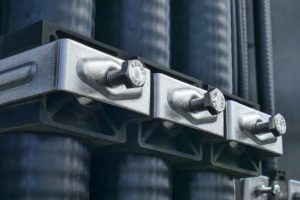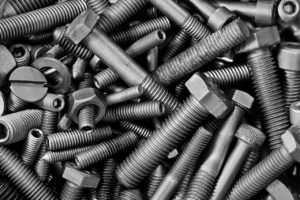How It’s Made – Per Part Screws

Manufacturing specialty screws is a complex process that had multiple different variables that must be taken into account. Screws are typically made from low to medium carbon steel wire, but other metals that are durable and less expensive (such as stainless steel, brass, nickel alloys, or aluminum alloy) can be substituted. It is crucial that quality metal is used to avoid cracking of the screw.
Machining is used for unique screw designs or for small screws that cannot be manufactured another way. The machining process is exact, however it is also very time consuming, wasteful, and expensive. As a result, the majority of screws are mass manufactured using the thread rolling method.
The specialty fastener manufacturing industry in the United States is currently thriving with many reshoring efforts aimed at buying American made products. There are also opportunities to buy fasteners from overseas markets as well, with Taiwan, China, and India making up the major players. Japan has also made a name for itself by manufacturing ultra-specialized fasteners, such as connecting rod bolts that are used in crankshafts.
The Manufacturing Processes
- Heat Treatment: Used to increase the overall durability the screw and includes two types of operations – hardening and tempering.
- Hardening: In this process, the fasteners are heated to a high temperature and dipped into a cooling media, such as water. The sudden transition in temperature hardens the screw material.
- Tempering: During this operation, the metal is heated to a temperature level below its critical point, and after this is complete, the screw is left to cool. The purpose of this is to reduce the excess hardness and brittleness of the fastener.
- Surface Finishing: This process includes certain operations that are meant to alter the surface of the screw and to enhance its functionality and aesthetic appeal. Surface finishing includes knurling, burnishing/reaming, and grinding.
- Knurling: A lathe is used to imprint crossed, angled, or straight lines into the metal material of the screw.
- Burnishing/Reaming: A tool is moved along the body of the fastener in a sliding motion to enhance the visual look of the surface finish.
- Grinding: A grinder is used to remove imperfections from the screw and to make the surface flat, smooth, or reflective in appearance.
- Thread Forming and Rolling: Thread forming or cutting is done to create threads on the inside or outside of the fastener using thread rolling dies which form various thread sizes without removing the metal material from the screw. The die is placed against the area for the desired threading and is moved in a circular motion – creating perfectly placed thread around the body of the screw.
- Protective Coating: This last step involves coating the screws with a protective coating that prevents rust or corrosion. It can also change the appearance of the screw by adding a particular color, if desired.
